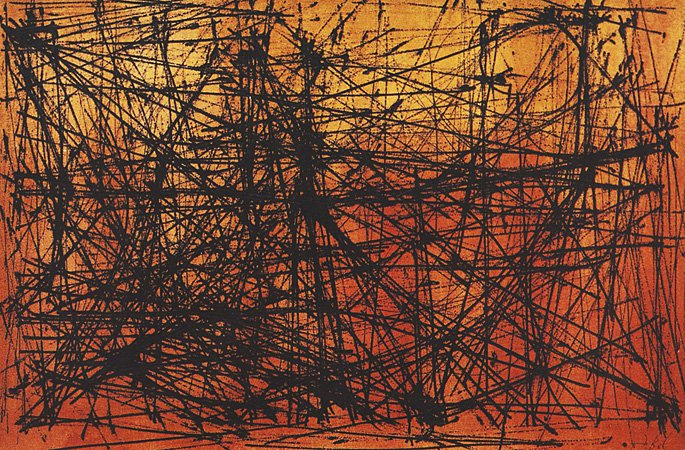Cultural Center of the Philippines
ENCYCLOPEDIA OF
PHILIPPINE ART
Saeta 22
(Arrow 22) / 1957 / Oil on canvas / 61 x 91 cm / Artist: Fernando Zobel / Jose Joya collection
Saeta is the title of a series of Zobel’s paintings done from 1957 to 1958 that are pure linear abstractions. These were inspired by the artist’s daily exposure to construction activities as he went about his work on his family’s real estate development project south of Manila. Graders, loaders, beams, cables, and scaffoldings of rising edifices became visual forms embedded in his mind. He perceived this as sheer linear motifs blazing a stark, desolate tropical skyline. With a needleless syringe filled with oil colors, Zobel drew slashing lines that cut across the canvas from one side to the other. On first impression, the Saeta could look like strands of yarn entangled between two knitting rods, or scratches of a draftsman’s blade cut across a plywood. On closer look, a viewer’s enticement is sustained by the motion of the linear cadence. Zobel stated: “The real subject matter of these paintings is movement—movement observed and felt, never imitated, yet dearly expressed.” Appearing improvised and spontaneous, the streaks are actually deliberate, set against a backdrop of bright orangey amber that gradate to a lighter tone.
Although Manila based at that time, Zobel was a constant traveler to the art centers of the world. This explains the influence of abstract expressionism and action painting as practiced by American artists such as Jackson Pollock and Willem de Kooning. Back in Manila, Zobel admired the works of his colleagues Arturo Luz and Lee Aguinaldo, a fact that reinforced his preference for the trend. The decisiveness and strength articulated in the black slashes of movement became a hallmark of Philippine abstract painting of the period, vis-à-vis the distinct styles of Vicente Manansala, Hernando R. Ocampo, and Cesar Legaspi.
Written by Imelda Cajipe-Endaya
